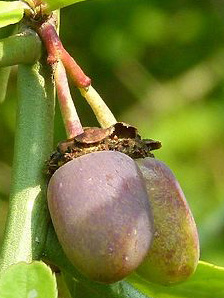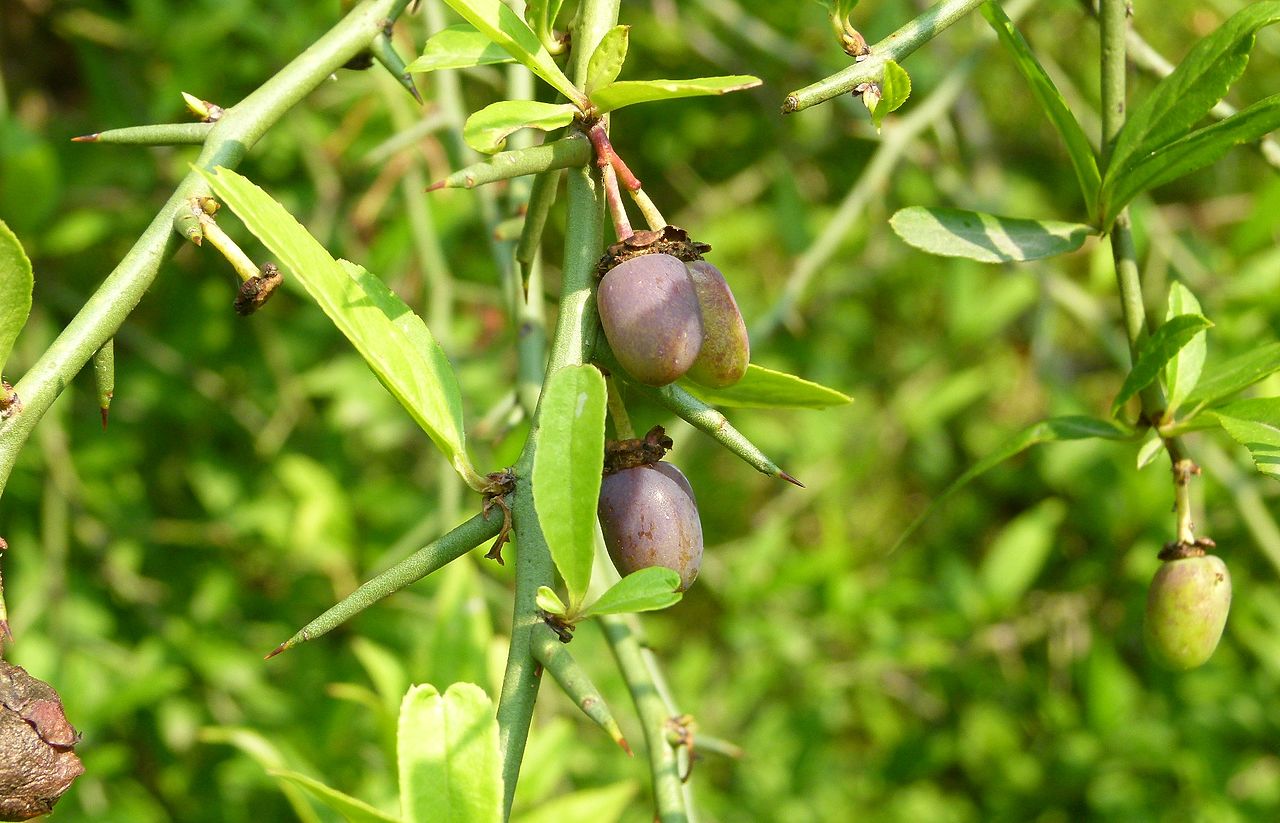 |
|
commons.wikimedia.org/wiki/User:Shyamal |
 |
| commons.wikimedia.org/wiki/User:Shyamal |
Translate this page:
Summary
Physical Characteristics

 Prinsepia utilis is a deciduous Shrub growing to 3.5 m (11ft) by 3 m (9ft). It is in flower in February, and the seeds ripen in June. The species is hermaphrodite (has both male and female organs) and is pollinated by Insects.
Prinsepia utilis is a deciduous Shrub growing to 3.5 m (11ft) by 3 m (9ft). It is in flower in February, and the seeds ripen in June. The species is hermaphrodite (has both male and female organs) and is pollinated by Insects.
Suitable for: light (sandy), medium (loamy) and heavy (clay) soils and prefers well-drained soil. Suitable pH: mildly acid, neutral and basic (mildly alkaline) soils. It can grow in semi-shade (light woodland) or no shade. It prefers moist soil.
UK Hardiness Map
US Hardiness Map
Synonyms
Plant Habitats
Woodland Garden Sunny Edge; Dappled Shade; Hedge;
Edible Uses
Edible Parts: Fruit Oil Oil
Edible Uses: Oil Oil
Fruit - raw or cooked[1, 2, 177, 183]. Liked by children[272]. Sloe-like[146], it has rather an astringent flavour[K]. The fruit is up to 17mm long and contains a single large seed[K]. An edible oil is obtained from the seed[2, 51, 105, 146]. It is used in cooking[183, 272].
References More on Edible Uses
Medicinal Uses
Plants For A Future can not take any responsibility for any adverse effects from the use of plants. Always seek advice from a professional before using a plant medicinally.
Eczema Miscellany Rubefacient Skin
An oil from the seed is rubefacient[240]. It is applied externally as a treatment for rheumatism and muscular pain caused by hard work[240]. The oil is also applied to the forehead and temples in the treatment of coughs and colds[272]. The heated oilcake is applied as a poultice to the abdomen in the treatment of stomachaches[272]. A paste of this seedcake is used as a poultice to treat ringworm or eczema[272]. The fruit is used in Chinese medicine[129]. We have no more details.
References More on Medicinal Uses
The Bookshop: Edible Plant Books
Our Latest books on Perennial Plants For Food Forests and Permaculture Gardens in paperback or digital formats.

Edible Tropical Plants
Food Forest Plants for Hotter Conditions: 250+ Plants For Tropical Food Forests & Permaculture Gardens.
More

Edible Temperate Plants
Plants for Your Food Forest: 500 Plants for Temperate Food Forests & Permaculture Gardens.
More

More Books
PFAF have eight books available in paperback and digital formats. Browse the shop for more information.
Shop Now
Other Uses
Hedge Hedge Miscellany Oil Oil Paint Soil stabilization Wood
The seed contains 21% of a fatty oil[240]. As well as being edible, it can also be used for lighting[2, 146, 158, 272]. The oilcake is used for washing clothes[272]. A deep purple colour btained from the fruits is used for painting windows and walls[272]. Plants are grown as a hedge in the Himalayas[1, 272]. Plants have an extensive root system and are used for binding the soil[272]. Wood - very hard, compact, very liable to split[158].
Special Uses
Carbon Farming Hedge Hedge
References More on Other Uses
Cultivation details
Agroforestry Services: Living fence Management: Standard Regional Crop Staple Crop: Oil
Succeeds in any moderately fertile well-drained soil in full sun or light shade[200]. Requires a light not too fertile soil[11]. Plants are hardy to about -10°c[184]. The plants produce flowers and fruits better when they are growing in full sun[200]. Flowers are produced on the previous seasons wood[200] and can be produced in the autumn as well as the spring. The flowers are produced on the current years wood according to another report[182]. Autumn flowers can produce ripe fruit in the following spring. Unfortunately, the plants only produce fruit in Britain after long hot summers[200].
Carbon Farming
-
Agroforestry Services: Living fence
Simply managed rows of shrubs and trees.
-
Management: Standard
Plants grow to their standard height. Harvest fruit, seeds, or other products. Non-Destructive management systems.
-
Regional Crop
These crops have been domesticated and cultivated regionally but have not been adopted elsewhere and are typically not traded globally, Examples in this broad category include perennial cottons and many nuts and staple fruits.
-
Staple Crop: Oil
(0-15 percent protein, 16+ percent oil). Some of these are consumed whole while others are exclusively pressed for oil. Annuals include canola, poppyseed, maize, cottonseed, sunflower, peanut. Perennials include high-oil fruits, seeds, and nuts, such as olive, coconut, avocado, oil palm, shea, pecan, and macadamia. Some perennial oil crops are consumed whole as fruits and nuts, while others are exclusively pressed for oil (and some are used fresh and for oil).
References Carbon Farming Information and Carbon Sequestration Information
Temperature Converter
Type a value in the Celsius field to convert the value to Fahrenheit:
Fahrenheit:
The PFAF Bookshop
Plants For A Future have a number of books available in paperback and digital form. Book titles include Edible Plants, Edible Perennials, Edible Trees,Edible Shrubs, Woodland Gardening, and Temperate Food Forest Plants. Our new book is Food Forest Plants For Hotter Conditions (Tropical and Sub-Tropical).
Shop Now
Plant Propagation
Seed - best if given 2 months cold stratification[113]. Sow the seed in autumn if possible, otherwise in late winter or early spring in a cold frame in light shade. Germination may be inhibited by light[113]. Prick out the seedlings when they are large enough to handle into individual pots. Grow them on in a greenhouse or cold frame for their first winter and plant them out in late spring or early summer of the following year. Cuttings of half-ripe wood, July/August in a frame[113].
Other Names
If available other names are mentioned here
Native Range
TEMPERATE ASIA: China (Guizhou Sheng, Sichuan Sheng, Xizang Zizhiqu, Yunnan Sheng) TROPICAL ASIA: Bhutan, India, Nepal, Pakistan
Weed Potential
Right plant wrong place. We are currently updating this section.
Please note that a plant may be invasive in one area but may not in your area so it's worth checking.
Conservation Status
IUCN Red List of Threatened Plants Status :

Growth: S = slow M = medium F = fast. Soil: L = light (sandy) M = medium H = heavy (clay). pH: A = acid N = neutral B = basic (alkaline). Shade: F = full shade S = semi-shade N = no shade. Moisture: D = dry M = Moist We = wet Wa = water.
Now available:
Food Forest Plants for Mediterranean Conditions
350+ Perennial Plants For Mediterranean and Drier Food Forests and Permaculture Gardens.
[Paperback and eBook]
This is the third in Plants For A Future's series of plant guides for food forests tailored to
specific climate zones. Following volumes on temperate and tropical ecosystems, this book focuses
on species suited to Mediterranean conditions—regions with hot, dry summers and cool, wet winters,
often facing the added challenge of climate change.
Read More
Expert comment
Author
Royle.
Botanical References
1151266
Links / References
For a list of references used on this page please go here
Readers comment
© 2010, Plants For A Future. Plants For A Future is a charitable company limited by guarantee, registered in England and Wales. Charity No. 1057719, Company No. 3204567.